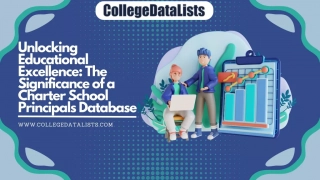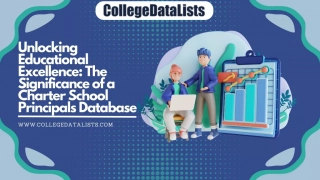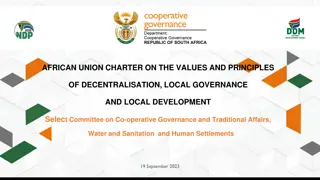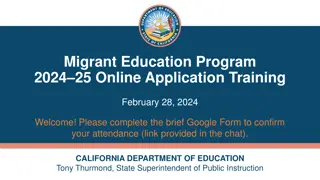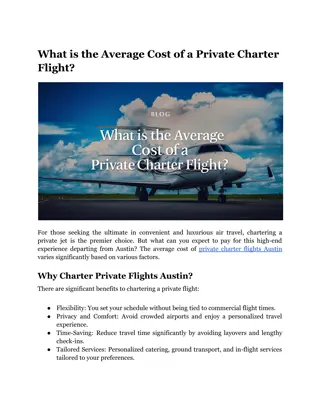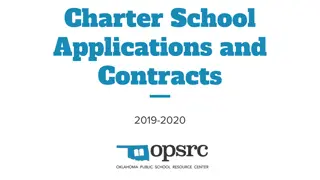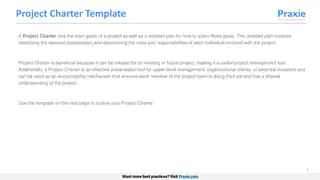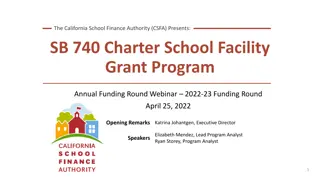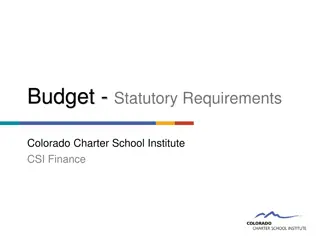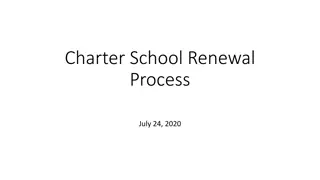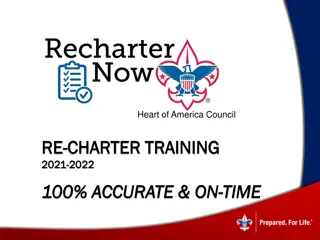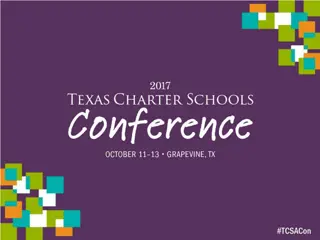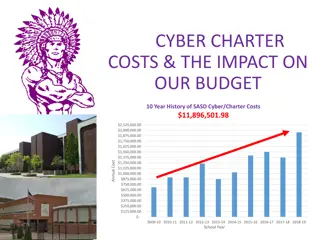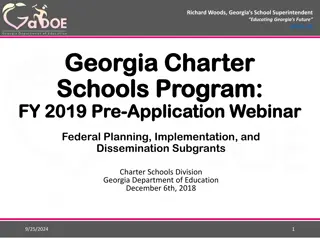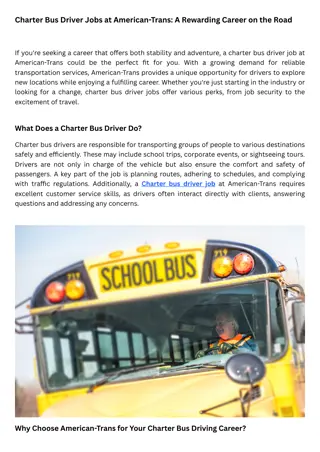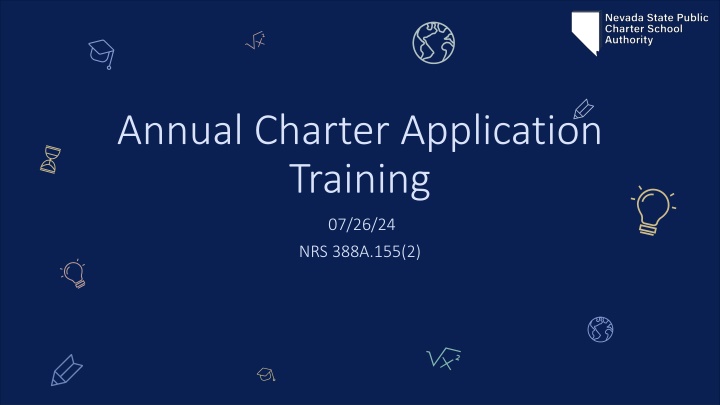
Charter School Application Process and Responsibilities Guide
Discover the core responsibilities and application process for charter schools, including evaluating, approving, and monitoring applications, entering contracts, conducting site evaluations, and more. Get insights into the lifecycle of a charter school and the approximate timeline of the application process. Learn about the criteria and components involved in the application overview, such as mission, vision, academic plan, parent, and community involvement.
Download Presentation

Please find below an Image/Link to download the presentation.
The content on the website is provided AS IS for your information and personal use only. It may not be sold, licensed, or shared on other websites without obtaining consent from the author. If you encounter any issues during the download, it is possible that the publisher has removed the file from their server.
You are allowed to download the files provided on this website for personal or commercial use, subject to the condition that they are used lawfully. All files are the property of their respective owners.
The content on the website is provided AS IS for your information and personal use only. It may not be sold, licensed, or shared on other websites without obtaining consent from the author.
E N D
Presentation Transcript
Annual Charter Application Training 07/26/24 NRS 388A.155(2)
Core Responsibilities of the Authority Evaluating, approving, and declining applications to form a charter school Entering into contracts with charter schools Monitoring the performance and compliance of each charter school Determining whether a charter contract should be renewed Determining whether a charter contract should be terminated Determining whether to approve or deny a request to amend a charter contract (ex., expansion, relocation, etc.) Conducting site evaluations
APPLICATION PROCESS If denied, possible Resubmission within 30 days 3. Completeness 3. Completeness Check Check 4. Application 4. Application Review Review 6.Recommendation 6.Recommendation to Board to Board 1. Letter of Intent 1. Letter of Intent 2. Application 2. Application 5. Capacity Interview 5. Capacity Interview Possible written clarifying questions Note: District and public input is included in the Application Review phase of the process.
APPLICATION PROCESS Approximate Timeline Capacity Capacity Interviews: Interviews: Findings and Findings and Recommendation Recommendation to Board: to Board: From submission From submission to to recommendation recommendation about 3 about 3- -4 months 4 months Completeness Completeness Check: Check: If denied, possible Resubmission within 30 days Initial Reviews: Initial Reviews: About 5 About 5- -6 weeks 6 weeks About 3 About 3- -4 weeks after initial review after initial review 4 weeks About 1 About 1- -2 weeks 2 weeks About 3 weeks About 3 weeks April 30 Late August November
Application Overview CRITERIA CRITERIA COMPONENT COMPONENT Mission & Vision Targeted Plan Parent & Community Involvement MEETING THE NEED MEETING THE NEED ACADEMIC PLAN ACADEMIC PLAN Transformational Change Curriculum & Instructional Design Distance Education Requirements (if applicable) Pre-K Requirements (if applicable) Promotion and High School Graduation Requirements Dual Credit Partnerships (if applicable) Driving for Results At-Risk Students & Special Populations School Structure: Culture School Structure: Student Discipline School Structure: Calendar & Schedule Board Governance Leadership Team Staffing Human Resources Student Recruitment/Enrollment Incubation Year Development Services Facilities Ongoing Operations OPERATIONS PLAN OPERATIONS PLAN Financial Plan FINANCIAL PLAN FINANCIAL PLAN May be required should the Committee to form seek to contract with a non-profit charter management organization (CMO) or for-profit educational management organization (EMO) OR apply as an experienced Non-Profit CMO ADDENDUM ADDENDUM 8
Charter School Evaluation Rubric Rubric Details The Evaluation Rubric is used by application evaluators and is completed individually by each evaluator. The Evaluation Rubric contains criteria for each section of the proposal. When evaluating an application, evaluators rate and provide a narrative analysis of each application section (Meeting the Need, Academic Plan, Operations Plan, Finance Plan, and Addendum). Within each section and subsection, specific criteria define the expectations for a response that Meets the Standard. An applicant must Meet the Standard in applicable sections of the application (Meeting the Need, Academic Plan, Operations Plan, Finance Plan, and Addendum) by the end of the application and evaluation process to be recommended for authorization. If an application Meets the Standard in all but one section and Approaches the Standard in the one remaining section, the application and proposed new charter school may be recommended for authorization if the remaining issues are specific and limited and the outstanding deficiencies can be addressed through conditions. 10
SPCSA Needs Assessment Demographic Need Academic Need Academic Need Applicants meeting this need will propose a school model that includes demonstrated capacity, credible plans, and thorough research and analysis in order to intentionally enroll and enroll and serve the following student groups, each of which has been identified as persistently underperforming based on data provided by the NDE: Students qualifying for free or reduced-price lunch (FRL), English Language Learners (ELLs), Students with Disabilities (those with an Individual Education Program, or IEP), Students in Foster Care, and Students Experiencing Homelessness. . Successful applicants will demonstrate the capacity to support these student groups in achieving academic performance at or above the state average. Applicants intending to Applicants intending to enroll and serve student groups that have historically enroll and serve student groups that have historically underperformed can be most impactful when they underperformed can be most impactful when they alleviate barriers to access, such as student alleviate barriers to access, such as student transportation needs. transportation needs. Geographies with 1 Geographies with 1- - and 2 Applicants meeting this need will propose a school model that includes demonstrated capacity, credible plans, and thorough research and analysis to intentionally provide access to 3-, 4- and 5-star schools in zip codes where a significant percentage of students are attending a 1- or 2-star school. Additionally, applicants meeting this need will provide Additionally, applicants meeting this need will provide intentional plans for partnering with the community intentional plans for partnering with the community and building on identified community assets to meet and building on identified community assets to meet the needs of students within the community. Simply the needs of students within the community. Simply adding a school option in a community with 1 adding a school option in a community with 1- - or 2 star schools will not inherently lead to effectively star schools will not inherently lead to effectively meeting the community needs. Rather, schools must meeting the community needs. Rather, schools must establish trust with the community by working in establish trust with the community by working in partnership to intentionally meet the needs of the partnership to intentionally meet the needs of the students and community. Alternative 3 students and community. Alternative 3- -, 4 options can be most impactful in communities that options can be most impactful in communities that currently have limited or no public charter school currently have limited or no public charter school options available options available. A map and list of zip codes is provided within this document; SPCSA charter schools are removed from the data set used to identify zip codes. Additionally, a map and list of Additionally, a map and list of existing SPCSA existing SPCSA- -sponsored charter schools, by zip code sponsored charter schools, by zip code is provided in Appendix B. is provided in Appendix B. and 2- -Star Schools Star Schools Students at Risk of Dropping out of School Students at Risk of Dropping out of School Applicants meeting this need will propose a public charter school model that includes demonstrated capacity, credible plans, and thorough research and analysis to enroll and enroll and prevent at-risk students from dropping out of school. Models may include but are not limited to programs designed for student groups that are most at-risk of dropping out or programs aimed at enabling credit-deficient students to get back on track to graduate. Applicants should demonstrate a strong understanding of grade-level appropriate indicators for successful high school completion, such as early literacy, attendance, and credit sufficiency and plans to enable students to successfully meet these milestones. Public charter schools aimed at enrolling and preventing at schools aimed at enrolling and preventing at- -risk students from dropping out of school can be most students from dropping out of school can be most impactful when they offer a unique academic impactful when they offer a unique academic experience for students and/or are closely aligned to experience for students and/or are closely aligned to Nevada s priorities for workforce and economic Nevada s priorities for workforce and economic development. development. or 2- - Public charter risk , 4- - or 5 or 5- -star star 11
Alignment to Academic and Demographic Needs Assessment Applicant meets one or more academic needs AND one or more demographic needs. Applicant meets one or more academic needs OR one or more demographic needs. Applicant does not meet eitheran academic need or a demographic need. Applicant will likely be recommended for approval by SPCSA staff so long as their application otherwise meets the standards set forth by the SPCSA in its application rubric. Applicant may be recommended for approval by SPCSA staff contingent upon the details of their application and may be subject to additional contract conditions, so long as their application otherwise meets the standard set forth by the SPCSA in its applicationrubric. Applicant may need to revise their academic plan or pick a new location in order to qualify for a recommendation - even if their application otherwise meets the standards set forth by the SPCSA in its applicationrubric. Likelihood applicant is approved
Governance 13
NRS 388(A).246 (20) and (25) Requires that as part of the charter school application, each applicant propose bylaws for the governing body, which must include a description of how the charter school will be governed, any governance training that will be provided to the governing body, and a code of ethics for members and employees of the governing body. Requires that as part of the charter school application, each applicant provide opportunities and expectations for involving the parents of pupils enrolled in the charter school in the operation of the charter school, including, how the charter school will solicit input concerning the governance of the charter school from such parents. 14
NRS 388A.240 A committee to form a charter school must consist of: (a) One member who is a teacher or other person licensed pursuant to chapter 391 of NRS or who previously held such a license and is retired, as long as his or her license was held in good standing; (b) One member who: (1) Satisfies the qualifications of paragraph (a); or (2) Is a school administrator with a license issued by another state or who previously held such a license and is retired, as long as his or her license was held in good standing; (c) One parent or legal guardian who is not a teacher or employee of the proposed charter school; and (d) Two members who possess knowledge and expertise in one or more of the following areas: (1) Accounting; (2) Financial services; (3) Law; or (4) Human resources. 2. In addition to the members who serve pursuant to subsection 1, the committee to form a charter school may include, without limitation, not more than four additional members as follows: (a) Members of the general public; (b) Representatives of nonprofit organizations and businesses; or (c) Representatives of a college or university within the Nevada System of Higher Education. 3. A majority of the persons who serve on the committee to form a charter school must be residents of this State at the time that the application to form the charter school is submitted to the Department. 4. As used in subsection 1, teacher means a person who: (a) Holds a current license to teach issued pursuant to chapter 391 of NRS or who previously held such a license and is retired, as long as his or her license was held in good standing; and (b) Has at least 2 years of experience as an employed teacher. The term does not include a person who is employed as a substitute teacher. 15
NRS 388A.224 The SPCSA must establish standards and provide training regarding those standards before the school opens and every three years after that. The SPCSA must also develop a list of approved organizations that may provide similar training. Governance Standards Governance Training Approved Training Providers 16

